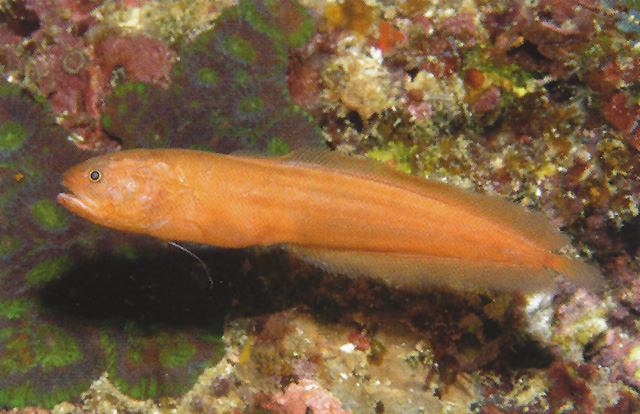| Dinematichthyidae (Viviparous brotula) |
| 7 cm SL (male/unsexed) |
|
reef-associated; marine; depth range 0 - 20 m |
| Western Pacific: Japan (Ryukyu Is.), Taiwan to northern Philippines, southwards to about 10°N. Further south, across the equator, iti is replaced by Diancistrus alleni. |
|
Dorsal spines (total): 0; Dorsal soft rays (total): 74-85; Anal spines: 0; Anal soft rays: 58-69; Vertebrae: 43-45. Diagnosis: This species is distinguished by the following: Vertebrae 11+32-34=43-45, dorsal fin rays 74-85 (usually >77), anal fin rays 58-69, D/V 6 (rarely 7); eyes moderately large (2.4-3.4% SL); outer pseudoclasper with hook-shaped extension oriented backward at 90° angle and slightly bent outwards, with a rounded tip; inner pseudoclasper short, joined to outer pseudoclasper anteriorly, with supporter, with small hook and wide thin flap at its base; scale patch on cheek with 5-6 scale rows on upper cheek, scales on operculum only above opercular spine, 3-7 scales in 2 rows; head profile slender, broad; otolith length to sulcus length about 2.0, sulcus not inclined (Ref. 57884).
Description: Anterior nostril low, close to upper lip. Caudal fin well developed, not united with dorsal and anal fins. Distinguished from B. erythrea by its more numerous longitudinal scale rows (Ref. 559).
Description: Characterized by depth of body at anal fin origin 16.7-20.6 (mean=18.5) % SL; long and straight penis (Ref. 90102). |
| Rare species, known from a single male specimen (Ref. 34024). Solitary inhabitant of coral reef crevices to at least 20 m depth, cryptic (Ref 90102). |
|
Least Concern (LC); Date assessed: 15 August 2019 Ref. (130435)
|
| harmless |
Source and more info: www.fishbase.org. For personal, classroom, and other internal use only. Not for publication.

